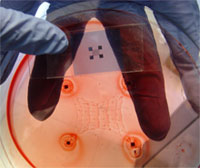A new design for silicon-based chips makes it possible to mechanically stretch them out to cover large areas. These expanded chips, which could be thousands of times the size of the original, could be used to make cheaper solar panels, sensor networks, and flat-screen TVs.
The chips, built by researchers at Stanford University, consist of free-floating islands of silicon surrounded by coils of silicon wire. Each island can be processed to include transistors, sensors, or materials for tiny solar cells. When the corners of the chip are pulled on, the coils around the silicon islands unwind. As they do, the islands, which start out nearly touching each other, spread apart. The end result is a netlike array of silicon devices.
So far the researchers have demonstrated arrays that are 50 times larger than the original chip, but they've been limited by the size of their laboratory equipment. Peter Peumans, the professor of electrical engineering at Stanford who led the work, says that the chips could be made to expand thousands, or even tens of thousands, of times. Peumans's work was presented this week at the International Electron Devices meeting in Washington, DC. Read

